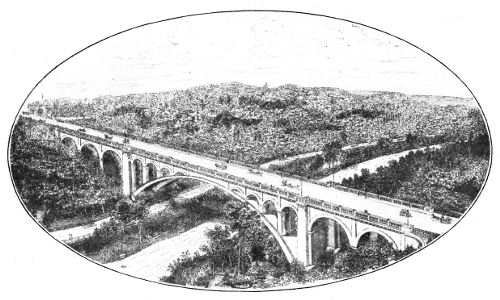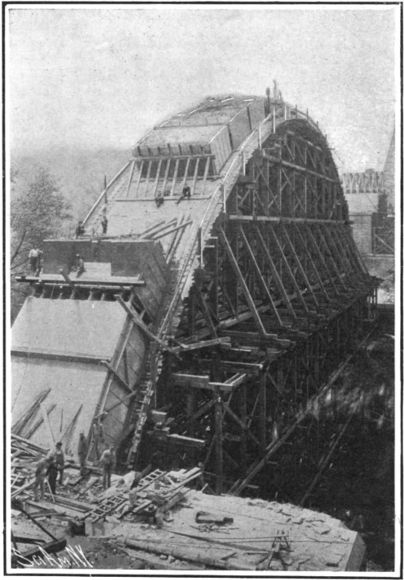Here Is the World's Greatest Concrete Bridge
Philadelphia—There was completed within the last year a notable engineering structure. Spanning the historic and wildly picturesque valley of the Wissahickon in Fairmount park, Philadelphia, the Walnut Lane bridge—the greatest concrete arch in the world and third largest masonry arch—connects two outlying districts of the city and opens up a new territory for suburban homes. The outskirts at historic Germantown and the hills of Roxborough, heretofore separated by a wide and deep valley and communicable only by devious and round-about roads, are now one.
The points of interest about the bridge are its size, the material of which it is constructed, the method of construction and the artistic treatment of the design. In point of size two masonry arches abroad exceed it in proportions, but neither here nor abroad is there anything approaching it fashioned out of concrete.
Its total length is 585 feet, divided into one main span of 233 feet in the clear and 70 feet rise, and five approach arches, two on one side and three on the other of 53 feet span each. The width over all of the bridge is 60 feet, comprising a roadway 40 feet and two sidewalks 10 feet wide. At present it is only a highway, but provision has been made to carry surface cars. The clear height of the crown above the bed of the Wissahickon is nearly 150 feet.
The main span is a twin arch surmounted by a series of spandrel arches which in turn carry the roadway. Each rib, complete in itself and constructed separately, is composed of 17 blocks or voussoirs of concrete, each cast as a monolith by itself. The depth of the ring at the haunch is 9 feet 6 inches and the width 21 feet 6 inches, while the corresponding proportions at the crown are 18 feet and 5 feet 6 inches respectively.
It is a true arch in every respect, being calculated to avoid tension in any part. A reinforced concrete arch might have been used of much slenderer proportions, but the heavier, massive arch was selected to better harmonize with the rugged setting.
The surface of the bridge and abutments resembles granite very closely. This effect. was secured by introducing into the molds a facing mixture of crushed black trap-rock, which when crushed resembles granite particles. The rough surface texture was secured by removing the face molds while the concrete was green and with a stream of water, assisted by a block of wood, scouring out the surface film of ceemnt , thus exposing the rock particles and producing a light diffusing face.
From an engineering point of view the most interesting feature of the whole bridge was the construction of the form-work to carry the arch until it was completed. In the bed of the stream were set a series of long narrow concrete piers, upon which a structure of falsework of mingled steel and wood, six stories in height, 233 feet long and over 140 feet high, was erected.
This formed the support for the casting of the arch ring in place, the materials being transported by means of an overhead cableway from the mixing plant on the hilltop,' After the first ring was completed the entire fabric of temporary structure was lowered away by means of wedges until it was clear of the arch, and by means of horizontal screw-jacks, working on the concrete piers, was moved bodily over until it was in position to center the twin ring.
The whole operation of moving the falsework consumed three days and in a fortnight after the operation of striking the centers from under the first arch and construction of the second was begun. Attesting the correctness of the design of the falsework and the accuracy of its construction and manipulation, is the fact that when struck the deflection of the arch at the crown was a scant 1-16 inch, and at the quarter point 1-32 inch, with absolutely no sign of cracking.
From the artistic viewpoint. the Walnut Lane bridge is considered beautiful. The true test is the impression one gets of its truly noble span when approaching along the winding bank of the Wissahickon, a bold bow of somber gray silhouetted against the sky and apparently losing itself at either extremity in the thickly wooded hillsides.
The designs for this bridge were executed in the offices of the engineering department of the city of Philadelphia—George Webster, chief engineer, and Henry H. Quimby, assistant engineer. The time consumed was about a year and the contract price $253,551.


